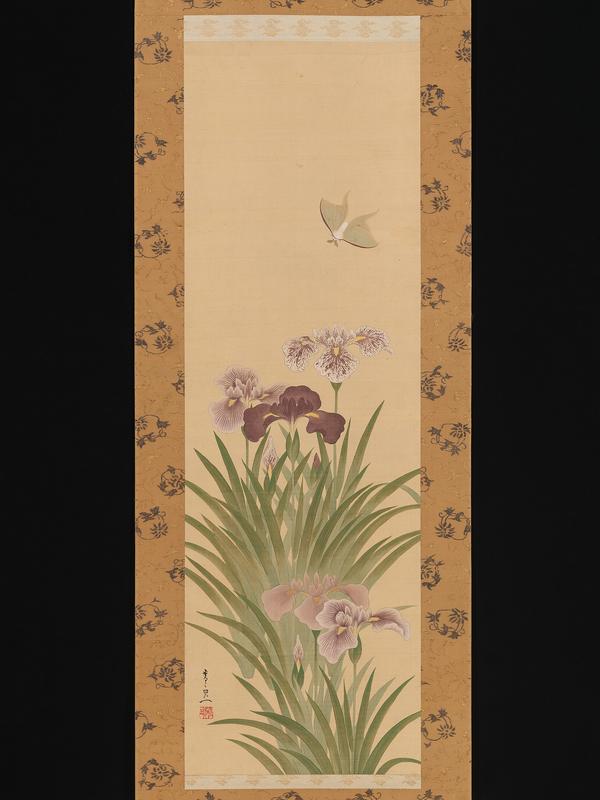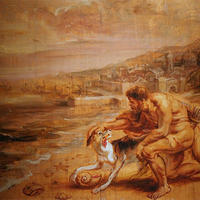More about Irises and Moth

Contributor
Irises and Moth is just as original as it was when Kiitsu made it, with ink on a silk scroll, around 1850 CE.
The relationship between iris and moth stays relevant, especially if you're a gardener dealing with a case of parasitic iris borer moths, which you can fight with nematodes. There are two ways to display this scroll: you can mount it or you can attach knobs to it and hang it, which makes its overall size about three times the size of the image itself. As of this writing, the Met is not displaying it publicly, so they don't need to decide whether to show it in scroll mode or mounted mode. In keeping with the general movement of the Rimpa school in which he worked, Kiitsu has shown us a scene of irises and a moth removed from their environment, as if in a laboratory. This work is undated, like nearly all of his works, and signed with the name "Seisei," which means "spiritual refinement." Tsuji Nobuo has developed a system of dating Kiitsu works by his changing signatures; "Seisei" indicates that this is a late-career piece.
By removing the background in which you might find such a scene, the artist is directing our attention toward the relationship between each of the elements of the work, rather than any individual, central, controlling influence. For example, what is the focal point of this work? Where are you supposed to look? The moth is a little too humble of a creature to be the star of the show, and it wavers at the periphery of the composition, unsure of itself. The flowers, like Kiitsu's Morning Glories and the earlier Rimpa work Ogata Korin's Irises, are evenly spaced, suggesting the influence of architecture. In fact, the late Mary Griggs Burke, who initially brought this piece from Japan to New York, became interested in Japanese art through her architectural work with Walter Gropius, who was working in Japan at the time and designing a house for her in the States. That's the beginning of the "long answer" she gives as to why she amassed such an enormous collection of Japanese art that she had to rent an entire Upper East Side apartment and hire a curatorial staff for it. Not many people can afford a view of central park, but Irises and Moth could.
Burke's maternal grandfather, Crawford Livingston, was a Midwest railroad tycoon, or, in her words, a "robber baron." Once an emeritus trustee of the Met, Burke epitomizes Leo Castelli's maxim that great collectors are as rare as great artists. She was proud of her eccentricities—her famous "short answer" explaining her fascination with Japanese art, quoted in her New York Times obituary, is that "it's a deep neurotic need better left unanalyzed." Better for her, I guess. In the extended interview from which the Times pulls this quote, Burke says that she was interested in Japan partly because it was not yet a tourist attraction and, at that time in the mid-'50's, it was barely rebuilding after the devastating bombs that the U.S. dropped during the war. A student of the painter Bradley Walker Tomlin and the mythologist Joseph Campbell (famous for his "Hero's Journey" theory of literature), Burke married a typesetter and book designer the year after her first sojourn in Japan, of whom she said, "I've often accused him of marrying me for my house because he seemed to like it so much!"
Sources
- Fox, Margalit. "Mary Griggs Burke, Japanese Art Connoisseur, Dies at 96." The New York Times, Dec. 18, 2012, https://www.nytimes.com/2012/12/18/arts/design/mary-griggs-burke-collec….
- Hahn, Jeffrey, and Jody Fetzer. "Iris Borers." University of Minnesota Extension, 2018, https://extension.umn.edu/yard-and-garden-insects/iris-borers.
- "Irises and Moth." The Met, https://www.metmuseum.org/art/collection/search/53424?searchField=All&s….
- Link, Howard A., and Tōru Shimbo. Exquisite visions: Rimpa paintings from Japan. Honolulu: Honolulu Academy of Arts, 1980.
- Murase, Miyeko. Art Through a Lifetime: The Mary Griggs Burke Collection, Volume 1. New York: Mary and Jackson Burke Foundation, 2013.
- Nobuo, Tsuji, et al. Nyūyōku Bāku korekushon-ten: Nihon no bi sanzennen no kagayaki / Enduring Legacy of Japanese Art: The Mary Griggs Burke Collection. Exh. cat., Museum of Fine Arts, Gifu; Hiroshima Prefectural Museum of Art; Tokyo Metropolitan Art Muse
- Zane, Sharon. "Oral history interview with Mary Griggs Burke, 1995 June 28." the Met, https://libmma.contentdm.oclc.org/digital/collection/p15324coll10/id/23….












